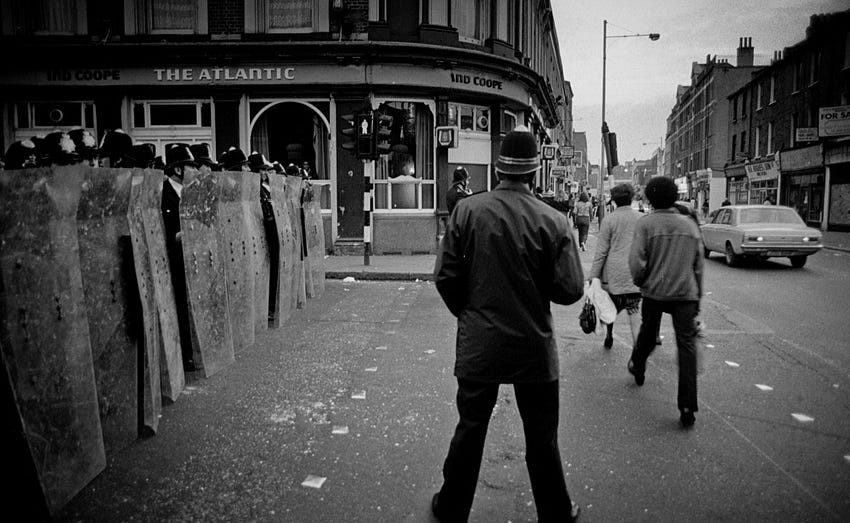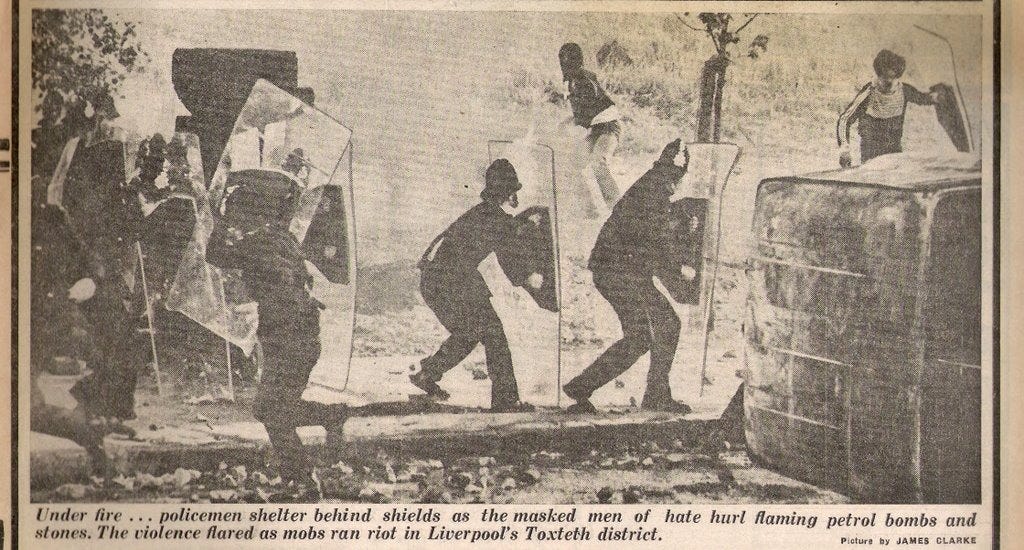This story traces back to 1948, when the HMS Windrush – a sort of Mayflower in reverse – docked in Tilbury, Essex. On board were people from Jamaica 🇯🇲, Trinidad 🇹🇹, St. Lucia 🇱🇨, Grenada 🇬🇩, and Barbados 🇧🇧. They were entitled to British passports and the right to seek employment in mainland Britain, as the UK needed fresh manpower for post-WWII reconstruction.
Those who arrived from the West Indies up to 1971 came to be known as the Windrush Generation. These UK citizens settled in working-class neighborhoods in cities like Liverpool, Birmingham, and London, where they faced racism, discrimination, and poverty.
In Toxteth, Liverpool, the Caribbean community lived in rundown areas, where youth unemployment among Black residents reached 60%. They were also subjected to aggressive police searches and abuse.
Events prior to the Liverpool clashes 🇬🇧

On January 18, 1981, during a birthday party in New Cross, London, a fire broke out, killing 13 young Black people. The area was already known for racial tensions, with frequent clashes between the local Black community and far-right National Front activists. Police downplayed the tragedy, fueling widespread anger.
On March 2, thousands of West Indian immigrants gathered peacefully in Fordham Park to demand justice and police accountability. Tensions escalated into clashes.
By April, Operation Swamp 81 — a plainclothes police campaign in Brixton based on the Victorian-era sus law — intensified frustrations. The law allowed stop-and-search without evidence, disproportionately targeting Black youth. In five days, thousands were searched, and 82 were arrested.
On April 10, the death of Michael Bailey triggered protests. The next day — Bloody Saturday — saw riots erupt: police were attacked with stones and petrol bombs, shops were looted, and the area was left in ruins. Dozens were injured.
The Battle of Toxteth 💥
After the unrest in Brixton and other cities, the victory of Bob Paisley's Liverpool in the European Cup Final against Real Madrid at the Parc des Princes seemed to provide a temporary relief.
However, between July 3rd and 11th, 1981, Toxteth exploded in a wave of unrest sparked by the arrest of Leroy Cooper. The community, including Afro-Caribbeans, Pakistanis 🇵🇰, and Indians 🇮🇳, had long suffered under the weight of economic decline and institutional racism.
The Skinhead faction of the National Front openly called for the expulsion of the UK’s three million non-white residents, most of whom worked in low-skilled jobs.
On July 4th, the riots reached their peak: 150 buildings were burned, 780 police officers were injured, and mass looting took place. Prime Minister Margaret Thatcher stated that "nothing can justify violence" and insisted that there were “no easy solutions” to the UK’s economic woes.
The Labour Party, meanwhile, criticized Thatcher’s government for failing to prevent or adequately address the crisis.
Thatcher, Scarman, and the Task Force 👨✈️
Following the Brixton riots, the Scarman Report analyzed the root causes of the unrest, identifying a volatile mix of racism, social inequality, and police-community mistrust. It called for reforms, including improved recruitment of ethnic minorities into police forces and proactive employment policies to reduce youth unemployment.
The report famously warned:
“Urgent action is needed if it is not to become an endemic, ineradicable disease, threatening the very survival of our society.”
In response, Thatcher appointed Michael Heseltine as Minister for Merseyside. His Merseyside Task Force aimed to regenerate the local economy through infrastructure investment and the rehabilitation of neglected areas. Heseltine requested £100 million to implement his plan, but the government granted only £15 million and instead floated the idea of a "managed decline" for Liverpool — a strategy that many saw as abandonment.
Conclusion 🔥
In 1981, a wave of riots swept through Britain, rooted in economic disparity and institutional racism. The New Cross fire in January, the Brixton riots in April, and the Toxteth uprising in July formed a chain reaction.
The unrest then spread to Handsworth (Birmingham), Moss Side (Manchester), Chapeltown (Leeds), and Leicester. These areas experienced lootings, arson, and violent clashes, driven by common factors: 60% youth unemployment among Black communities, persistent poverty, and disproportionate police actions, especially stop-and-search abuses.
The Scarman Report acknowledged these systemic issues, but government responses remained limited. The year 1981 remains a cornerstone in the history of Black Britain — a moment of rupture that exposed the fractures of a post-colonial society in crisis.
Please share this post with anyone who may find it interesting.







